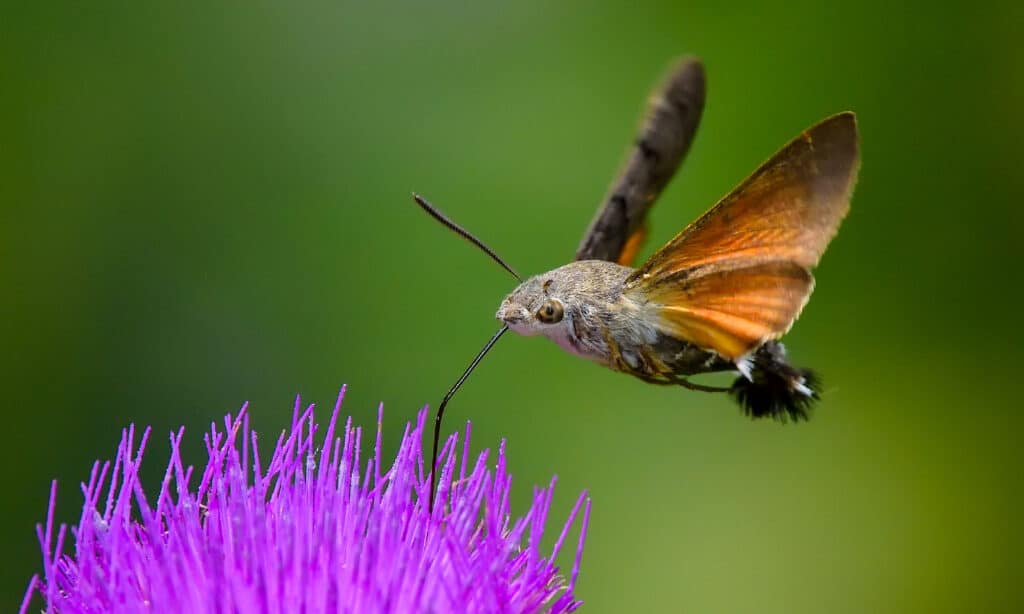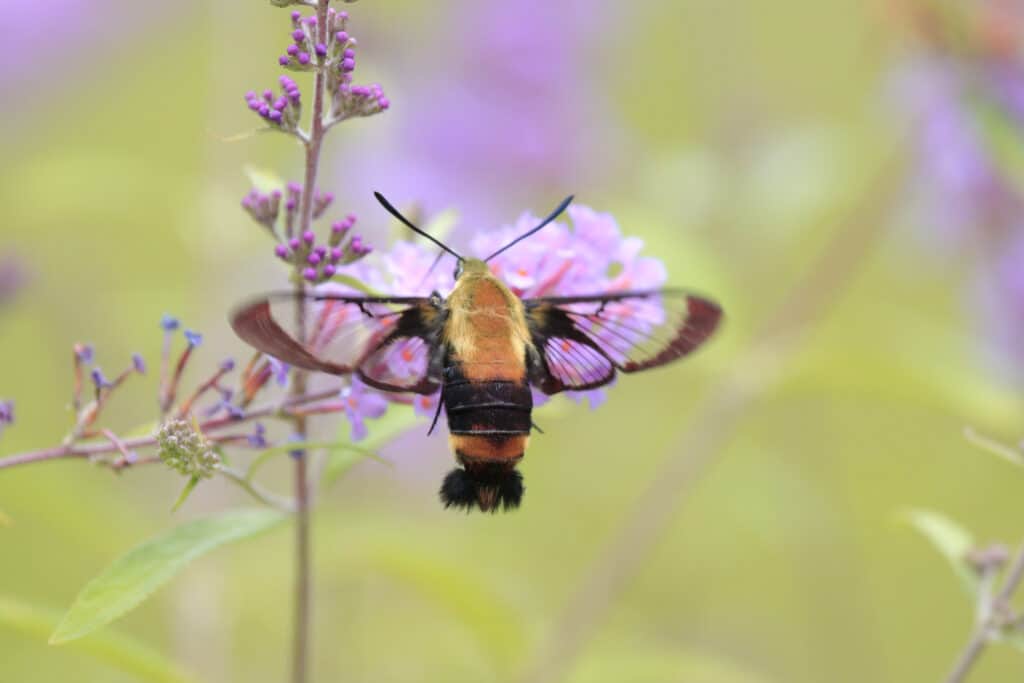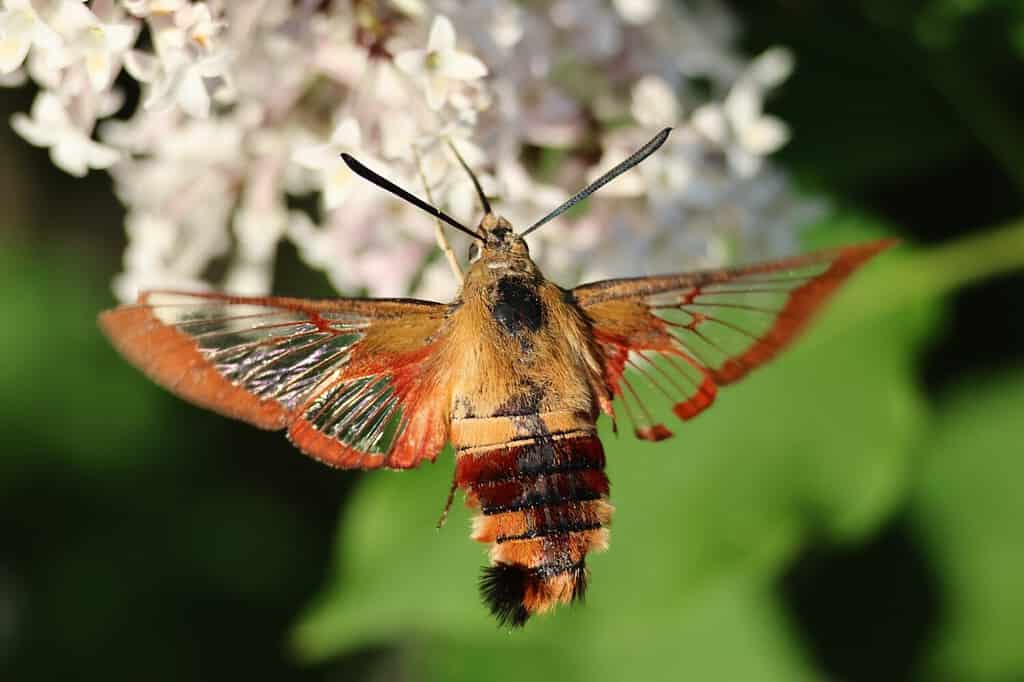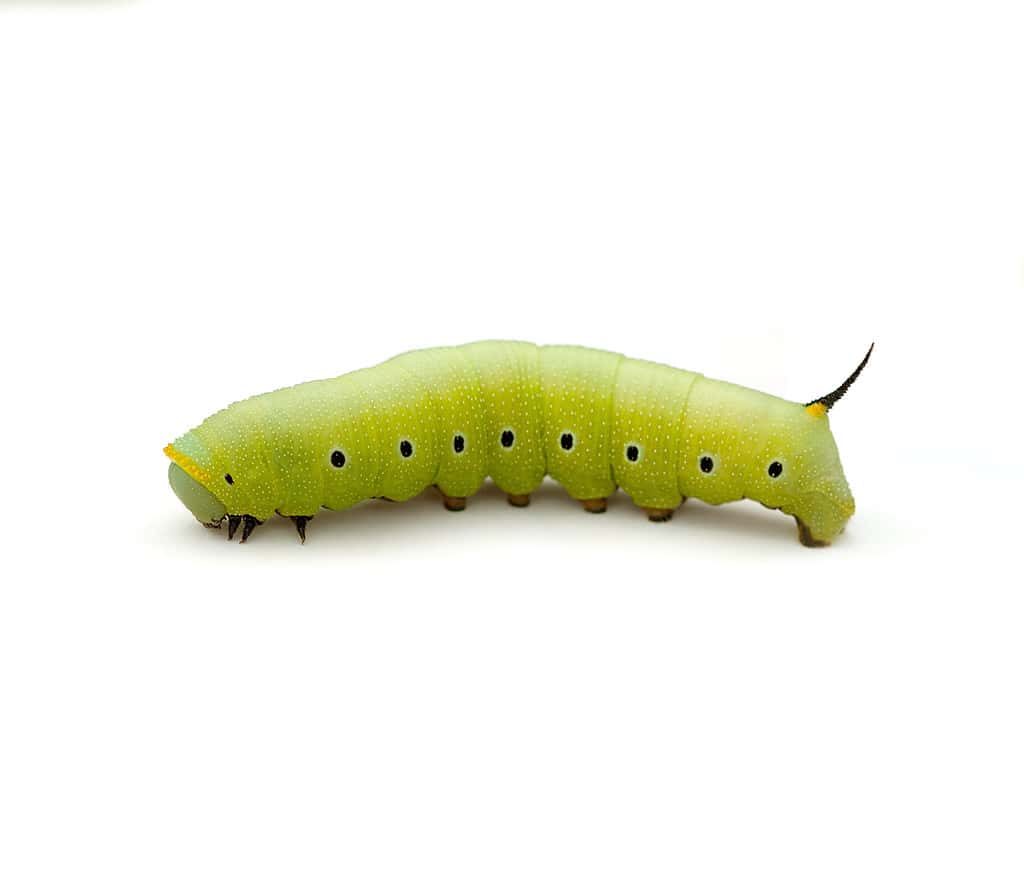Is it a moth? Is it a hummingbird? Sometimes, it’s just hard to tell! Some amazing moths give the appearance of hummingbirds, which can fool potential predators. Moths in the Sphingidae family, called Sphinx moths or hawk-wing moths, include around 1,400 or more species.
Many of these moths even have some of the same behaviors as hummingbirds, such as drinking nectar out of flowers and hovering near their food source. They can act as pollinators, making them valuable additions to the garden and landscape. If you think you’ve spotted a hummingbird, it’s worth taking a closer look. You might have seen one of these incredible moths instead!
#1 Hummingbird Hawk-Moth

Just like hummingbirds, these moths hover over flowers as they drink nectar.
©aabeele/Shutterstock.com
These incredible moths look so much like hummingbirds that they are routinely mistaken for small birds by people who are watching wildlife in the garden. Hummingbird hawk-moths are large, often getting up to 1.5 inches long. Like other sphinx moths, they have prominent forewings that move quickly to stay in one place, or hover, around a flower. They are native to Europe. Like hummingbirds, these moths use a long proboscis to drink nectar out of the center of flowers. They can hover at the flowers and move their wings to create the same humming sound that hummingbirds are famous for making.
The hovering flight of this hawk-moth is one of the most tell-tale signs that it is a hummingbird hawk-moth, although it also makes it easy to confuse them with actual hummingbirds. These moths have orange hindwings. When they move their wings rapidly as they hover, they often have an overall orange appearance. The forewings are grey or brown.
These moths can play an important role in pollination, just like bees, hummingbirds, or other animals that come into close contact with flowers. As they hover to drink nectar, hummingbird hawk-moths pick up pollen on their wings and bodies. Flying away, they deposit that pollen on other flowers and in the landscape to create new plants and growth.
#2 Snowberry Clearwing

Shortly after emerging as moths, snowberry clearwing moths lose scales on their wings, giving them the name clearwing.
©Walter Coate/Shutterstock.com
These moths are named for their clear wings, which give them a very distinct appearance. While they begin with rust-colored scales on their wings, these quickly fall off as they fly around. Like hummingbird hawk-moths, they flutter and hover at flowers to get nectar. They are quite stocky for a moth, with a broad body covered in hair. Their bodies are yellow and black. The coloring, along with the fuzzy appearance, makes them look similar to some species of bees. They likely evolved this way as a defense mechanism to potential predators, who now avoid them because they don’t want to get stung. The trick is on them, however, since snowberry clearwings do not sting. Overall, they are around 1.5 inches long. They have black legs which are some of their most defining features when compared to other moths in their family.
The snowberry portion of the moth’s name comes from their preferred food source while caterpillars. They eat the leaves and often make their cocoons on snowberry bushes. When they emerge as moths, they fly away to find nectar nearby. They do not have nearly as limited a palette when they are looking for nectar. These moths still like Snowberry plants, this time feeding on the nectar from the flowers instead of the plant leaves. They also eat honeysuckle, orange hawkweed, lilac, thistles, and others.
This species lives on the East Coast of the United States, although they can live in other parts of North America as well. They can be seen as north as Maine down to Florida in the south. Snowberry clearwing moths have an incredibly large range. They are active during the day, while many of their relatives are more active in the evenings or at night. You can spot them flitting from flower to flower, hovering as they drink nectar with a long proboscis.
#3 Hummingbird Clearwing

Hummingbird clearwings have dark red coloring, distinguishing them from other types of sphinx moths.
©Sam Hanrahan/Shutterstock.com
These moths have large, bulky bodies and long wings with particularly large forewings. This adds to their overall similarity in appearance to hummingbirds. The males of this species have a flared tail that makes the resemblance even stronger. This is typical of sphinx moths. At first glance, you might just confuse these moths for actual hummingbirds. But like other members of their family, they are much smaller than most hummingbirds. They generally top out around 1.5 inches long.
Hummingbird clearwings have dark red wings that can have clear centers if the scales fall off. Because the center scales often fall off, leaving only the dark reddish-brown outline, they have the name clearwing. The biggest difference between Hummingbird clearwings and Snowberry clearwings is their legs. While Snowberry clearwings have black legs, Hummingbird clearwings have pale-colored legs. Hummingbird clearwings also have darker red coloring on their abdomens. Just keep in mind that when these moths are hovering or flitting from flower to flower looking for nectar, it may be hard to distinguish them from each other. The red coloring might be a better indication if you can’t get a good view of the moth’s small legs.
#4 White-Lined Sphinx Moth

All sphinx moths can lift their heads as caterpillars, giving them the appearance of a sphinx.
©Wallenrock/Shutterstock.com
This species lives throughout North America. They prefer warmer climates where they can survive and get food. White-lined sphinx moths will migrate from the southern part of their range to the northern areas in the springtime. The body of this moth is brown and furry. They have olive green-brown wings with white stripes on them. These white stripes are one of their most defining features, although they can be hard to pick out when the moth is hovering and their wings move fast.
Like other sphinx moths, this species begins as caterpillars. When they lift their heads as caterpillars, the rest of their body stays flat, giving them an appearance similar to a sphinx. As caterpillars, white-lined sphinx moths are typically green or yellow, although the color can vary. They have a pointed horn that often has a black tip at one end. Once they reach around 3 inches long, they finish feeding on plant leaves and are ready to pupate and turn into moths.
#5 Rocky Mountain Clearwing

Rocky Mountain clearwing caterpillars eat plants until they mature and pupate to turn into moths.
©epantha/iStock via Getty Images
These moths live in, you guessed it, the Rocky Mountain states and the surrounding areas. They can be found in Colorado, New Mexico, Montana, Idaho, Wyoming, Utah, and California. They live in mountainous areas, feeding on flowers and other plants in meadows and forests. Like other sphinx moths, they have “horns” on the end of their bodies as caterpillars. These are not dangerous at all, however.
Rocky Mountain clearwings have fuzzy bodies that look very similar to bees. They have dark yellow and black or brown coloring. Like Snowberry clearwings, these moths likely benefit from the resemblance to bees. This tricks potential predators into thinking that they might sting, even though they do not have stingers. They look very similar to Snowberry clearwings, although they have a slightly different range. In fact, the main difference between the two is where they live. If you are in the western part of North America, chances are you are looking at a Rocky Mountain clearwing. On the eastern side, it’s likely a Snowberry clearwing.
Summary of Moths that Look Like Hummingbirds
| Number | Species | Scientific Name |
| 1 | Hummingbird Hawk-Moth | Macroglossum stellatarum |
| 2 | Snowberry Clearwing | Hemaris diffinis |
| 3 | Hummingbird Clearwing | Hemaris thysbe |
| 4 | White-Lined Sphinx Moth | Hyles lineata |
| 5 | Rocky Mountain Clearwing | Hemaris thetis |
The photo featured at the top of this post is © aaltair/Shutterstock.com
Thank you for reading! Have some feedback for us? Contact the AZ Animals editorial team.






